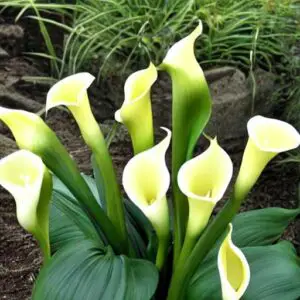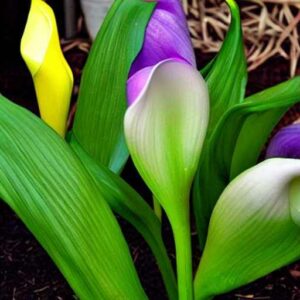Beautiful blooming plants known as calla lilies (Zantedeschia spp.) may be found in every garden. These South African native lilies hibernate over the hot, dry summers before blooming once again when the rainy season comes. If you provide calla lilies with the proper storage conditions over the winter, you may grow them even if you reside in a place with subzero temperatures. In order to guarantee their survival and healthy development the next season, we will talk about how to store calla lily bulbs in this post.
How to Store Calla Lily Bulbs
Getting Calla Flowers Ready for Storage
It’s time to get ready for storage after your calla lilies have done blooming and the leaves has begun to turn yellow. Start by removing any dead or rotting foliage by cutting it down to the ground. After that, gently remove the bulbs from the ground or container.
Selecting the Best Storage Facility
It is essential to store calla lilies somewhere where the temperature remains above freezing in order to avoid freezing and guarantee the bulbs stay healthy. You have a few possibilities, depending on your local environment and available space:
- Indoor Storage: You may store the bulbs in their pots if you are in an area with moderate winters. Put the pots somewhere that stays above freezing, such a garage, basement, or laundry room. Keep in mind to keep the soil moist, but not soggy.
- Storage in the Ground: You may leave the bulbs in the ground in regions with moderate winters and light frosts. Apply a layer of mulch over the bulbs before winter comes to act as insulation and shield them from frost. When the earth doesn’t freeze all the way through, this procedure works nicely.
Storing Calla Bulb Lily

Depending on your preferences and the resources at your disposal, there are many ways to store calla lily bulbs. Here are a few strategies that work:
- The term “loose” refers to a way of storing and transporting goods. Put them in air-circulating, well-ventilated containers like black boxes. This approach is comparable to how you could store potatoes or onions. It is crucial to make sure the bulbs are not in contact with one another as this may cause rotting.
- Newspaper Wrapping: You may also store the bulbs by individually wrapping them in newspapers, just as you would with dahlia bulbs. This technique serves as insulation and aids in moisture retention. Wrap the bulbs in plastic, then put them in a bag with a small hole to allow for air.
- Soil Storage: You may store the bulbs in soil as an alternate strategy. Place the bulbs into a bag filled with damp soil, being sure to cover them completely. Once again, keep the bag slightly open to avoid extra moisture accumulation.
Monitoring and upkeep
For calla lily bulbs to survive over the long term, ideal storage conditions are necessary. Check on them often to make sure they are not becoming too dry or too damp. If the bulbs seem too dry, you may provide moisture by spraying them briefly. To keep the bulbs at the ideal moisture level, you may either store them in soil or mix in a moist media like newspaper.
Success of Long-Term Storage
Calla lily bulbs may last for many years if properly stored. Calla lilies that had been preserved for up to three years have been successfully planted by some gardeners. When it’s time to plant them again, carefully take the bulbs from storage and look for any indications of damage or illness. In good soil, you may plant healthy bulbs, and with the right care, they will repay you with lovely blossoms once again.
How to plant calla lily bulbs in pots

Here are the essential steps to ensure successful growth and blooming of your calla lilies.
1. Choosing an Appropriate Pot: It’s important to choose a container for your calla lilies that will suit their unique requirements. The calla lilies need a deep container with a minimum height of 12 inches since their lengthy, tuberous roots need room to spread out. Additionally, check for drainage holes in the pot to avoid waterlogging and encourage strong root growth.
2. Soil Preparation Calla lilies grow best in well-draining, organically rich soil. Start by adding a premium potting mix to your selected container and moistening it before planting. To provide the plants the vital nutrients they need, you may also add some compost or organic fertilizer. Your calla lilies will flourish in a setting like this.
3. Planting the Bulbs: Insert the calla lily bulbs into the planter you just prepared. Make sure the pointed end, commonly known as the bullseye side, is pointing upward as you place the bulbs in the pot’s middle. To give the roots room to expand, the bulbs should be planted at a depth of approximately 3 to 4 inches. To prevent overcrowding when planting many bulbs, leave at least 2 to 4 inches between each one.
4. Covering and Watering: After setting the bulbs in position, fill the container all the way up with dirt to completely cover them. To remove any air pockets and give the bulbs support, gently push the dirt down. Water the container well after planting it until you notice water draining from the bottom. This first soaking encourages the growing process and enables the soil to become more stable. It’s crucial to maintain the soil consistently wet but not soggy during the growth season since too much moisture may lead to bulb rot.
5. Having said that, it’s important to note that the majority of the time, the majority of the time, the majority of the time, the majority of the time, the majority of the time. Put your potted calla lilies in a spot with at least six hours of direct sunshine per day. Select a location near a window that is well-lit if you are growing them inside. In order to promote healthy growth, keep the temperature around 60 to 75°F (15 to 24°C). Avoid subjecting the plants to extremes of temperature since doing so might stunt their development.
6. Consistent Care and Maintenance: Consistent care and maintenance are necessary to guarantee the success of your calla lilies. Following are some important pointers:
- Regularly water the plants to maintain a constantly wet but not soggy soil.
- Throughout the growth season, use a balanced liquid fertilizer every two to four weeks to encourage strong foliage and beautiful flowers.
- To preserve the general health and look of the plant, remove any dead or yellowing leaves.
- Keep an eye out for pests like aphids or spider mites, and if required, take the necessary steps to control them.
- To offer support and keep them from tumbling over, stake taller types or those with large flowers.
How deep to plant calla lily bulbs
The term “calligraphy” refers to the process of obtaining a license to practice a sport. The bulbs are stable and protected at this level, and the budding shoots have an easy time getting to the surface. It’s crucial to remember that depending on your unique growth circumstances and the size of the bulbs themselves, the depth may vary significantly.

Which side is up in Calla lily bulb Planting
Calla lily bulbs often have distinctive qualities that might help us choose the proper planting orientation. The bulb has a smooth surface on one side and a rough, maybe round side on the other. The secret to effectively growing calla lilies is to comprehend these characteristics.
It’s crucial to plant calla lily bulbs upright. The upward facing side of the bulb should have bumps or round regions. These bumps are the bulb’s developing points, and by positioning them so they face upward, we promote the growth of new shoots. Plant the bulbs gently in the ground, being sure to bury them about two inches deep.

How long do potted calla lilies last
I have written an in-depth article on this – Read full article.
Caring for Calla Lily Bulbs
The health and vitality of calla lily bulbs depend on proper maintenance. Here are some pointers for maintaining healthy calla lilies:
- Watering: Calla lilies cannot handle wet circumstances but like continually moist soil. Especially during dry seasons, give them frequent irrigation to keep the soil properly wet. Refrain from overwatering to prevent root rot.
- During the growth season, fertilize calla lilies once a month using a balanced, water-soluble fertilizer. For the correct application rates, according to the directions on the fertilizer package.
- Deadheading: Cut the stems close to the base of the fading blooms to remove them. Deadheading helps the plant concentrate its efforts on developing new flowers.
- Winter Care: Calla lilies need care throughout the winter months since they are not cold-hardy in colder climates. Trim the leaves and gently dig out the bulbs before the first frost. For the winter, keep them in a cool, dry area, then plant them again in the spring.
- Controlling pests and diseases: Calla lilies are often resilient to pests and illnesses. However, aphids, snails, or fungus infestations may sometimes harm them. Regularly check on your plants and respond appropriately if any problems occur.

Where to Buy Calla Lily Bulbs
You can buy calla lily bulbs from local nursery or online store. I have also provided the links to buy calla lilies from amazon. Buy Calla lily Bulbs.
The Origin of Calla Lily Bulbs
The colorful landscapes of South Africa are where calla lilies start their trip. These extraordinary blooms grow from subterranean storage organs called tubers. Calla lily bulbs have a thick, sturdy structure and are full of the nutrients and energy needed for the plant to grow and develop. Calla lilies stand out from many other floral plants because to their distinctive growth pattern.
Historical documents provide a window into the first documented occurrences of calla lilies. These alluring blossoms were shown in paintings from the Royal Garden in Paris that date back to 1664, suggesting their existence in European gardens at that time. Calla lilies weren’t legally brought to Europe until the 18th century, but they immediately became well-known there, especially during the Victorian period.
The fact that the term “calla lilies” is used to describe a group of people who have been in the same position for a long time is a testament to the power of the internet. Ancient Greece is where the term “calla” first appeared, where it came to represent beauty. This connection between the flower and beauty comes from a myth that had a significant cultural impact on Greek society.
Ancient Greek mythology regarded the calla lily as a symbol of stunning beauty. The tale describes the metamorphosis of Calla, a nymph of unrivaled elegance and beauty. She attracted the gods’ attention with her bright beauty, who changed her into the alluring white flower we now know as the calla lily. This fascinating legendary origin weaves together the blooms’ beauty, grace, and enduring fascination.
The term “calla lilies” refers to a group of people who have been given the task of completing a task. Calla lilies are often connected with chastity, innocence, and beauty throughout a wide range of civilizations. They are a popular option for weddings, religious ceremonies, and other important occasions because of their immaculate white flowers, which convey a feeling of peace and elegance.
Calla lily flower associated with fresh beginnings and rebirth. These blossoms are symbolic of new beginnings and constructive change in many cultures. Their ascent from the earth, bursting out with grace and vitality, is a reflection of the path of personal development and rejuvenation.
Conclusion
The health and future development of calla lily bulbs depend on properly storing them throughout the dormant season. You may make sure the bulbs endure in excellent shape and flourish when the growth season resumes by using the techniques described in this article. Keep the proper balance of moisture and temperature whether you select loose storage, newspaper wrapping, or soil storage. You may enjoy the beauty of calla lilies in your garden year after year with a little maintenance and care.
Related Posts:
Are Calla Lilies Perennial or Annuals?
Calla Lilies In Pots – Do They Grow Well(Care, How to)
Do Calla Lilies grow well in Florida? All You Need to Know
Deadhead Calla Lily – How and When to Cut Back
Calla Lily – Cuttings, Propagation, Spreads, Rhizomes(Care)
Calla Lily Varieties A Guide to Different Colors and Shapes
Calla Lily Leaves but No Flowers
What Is the Meaning Behind White Calla Lily Flowers
